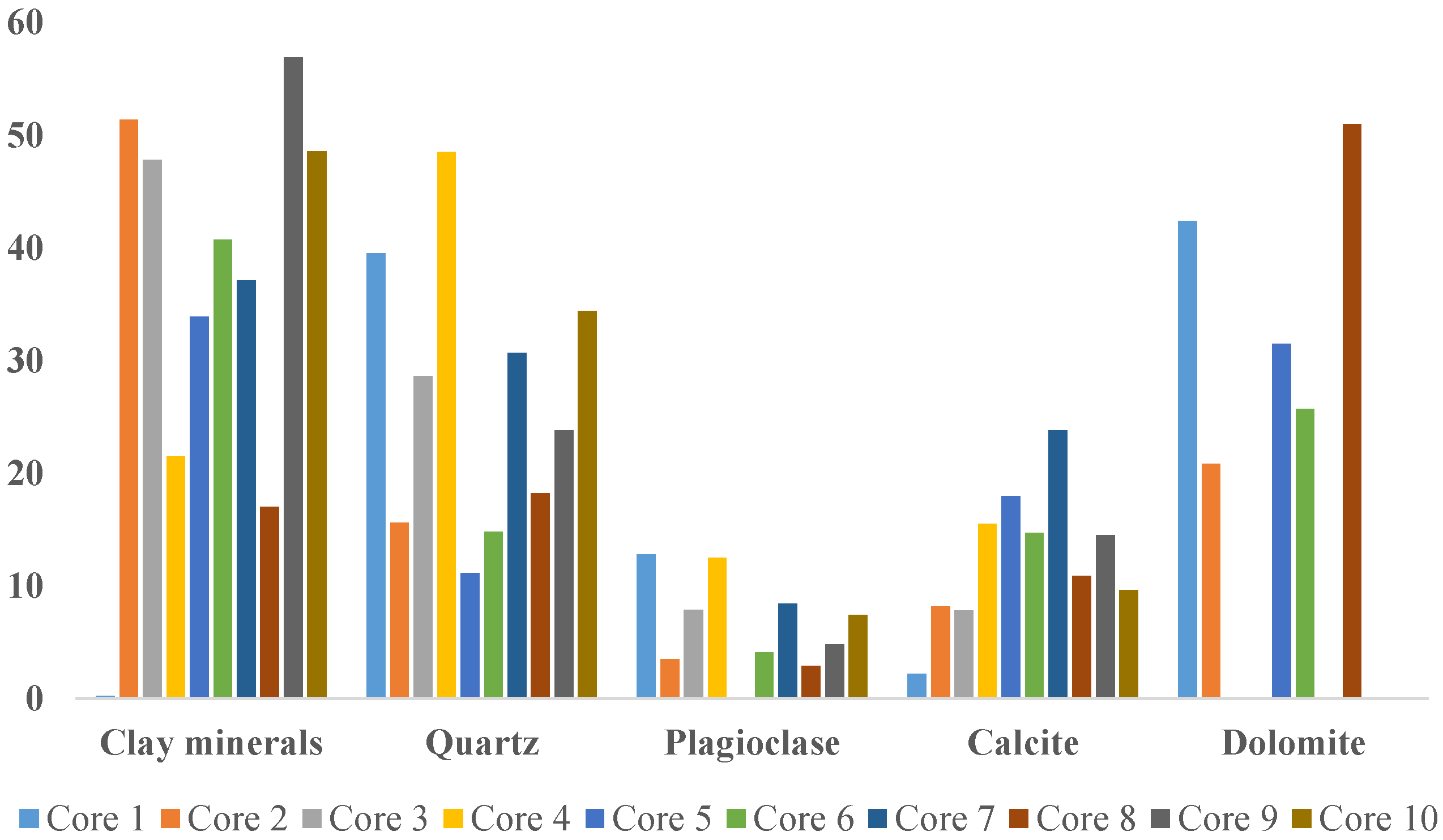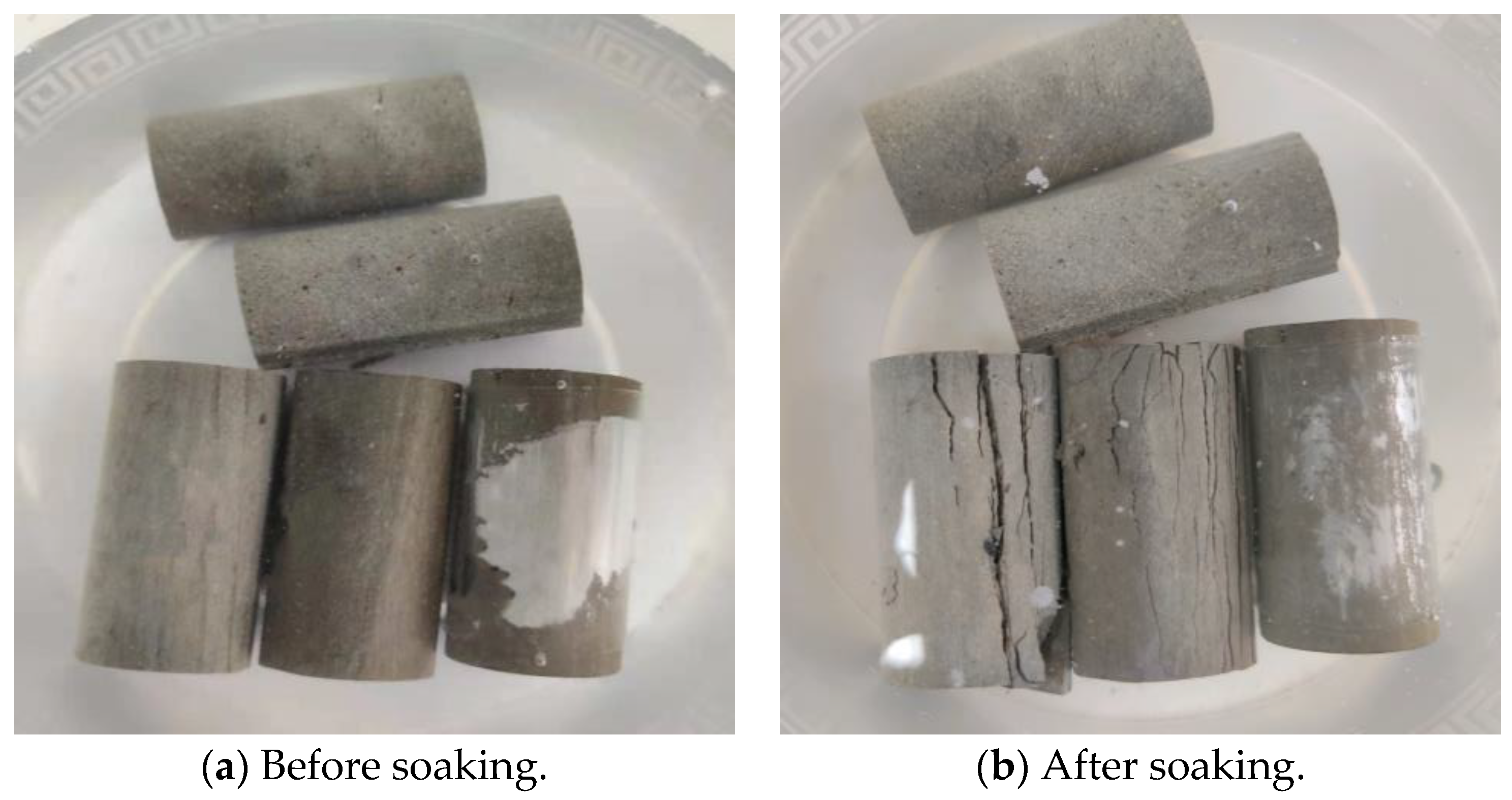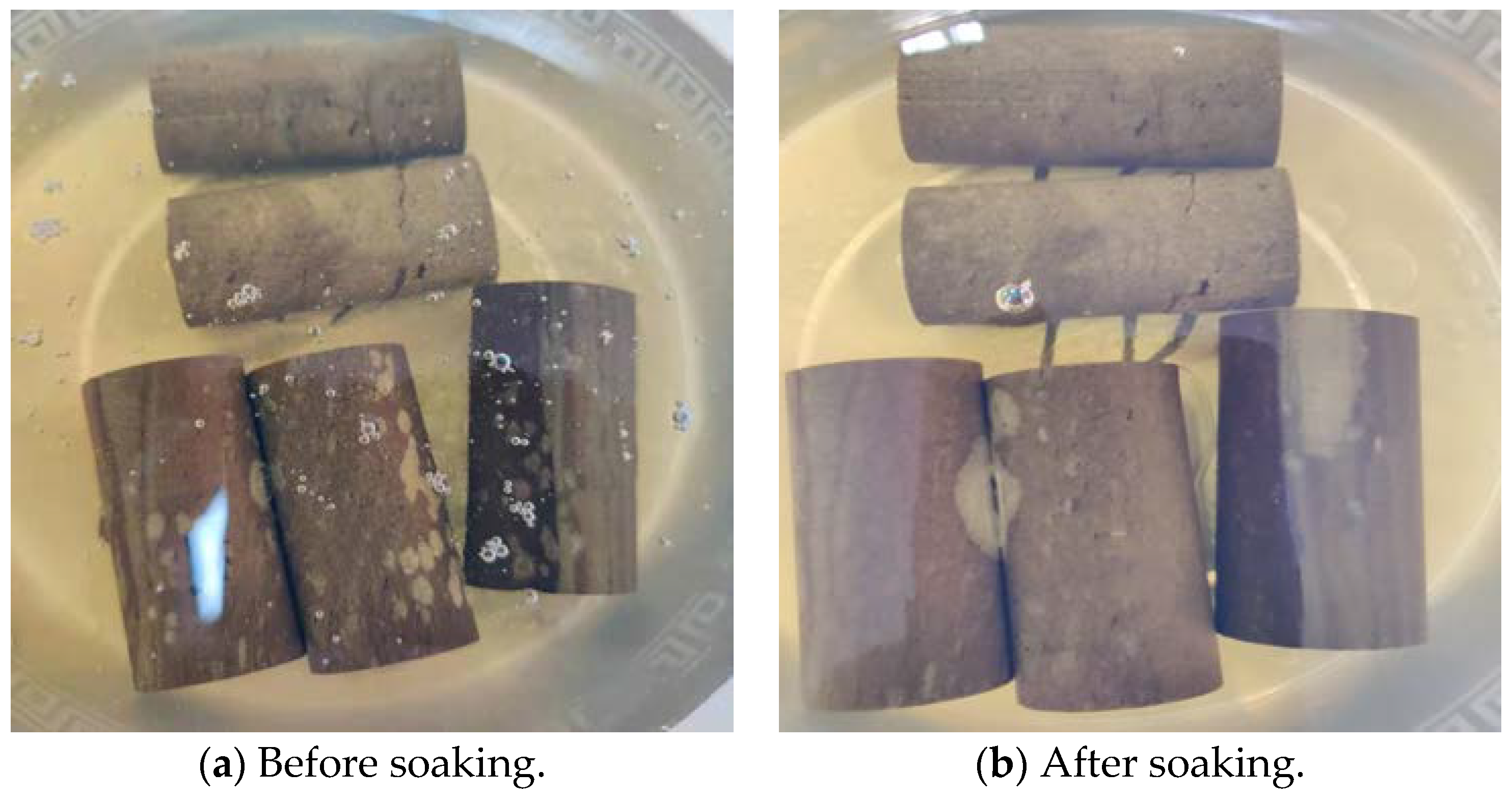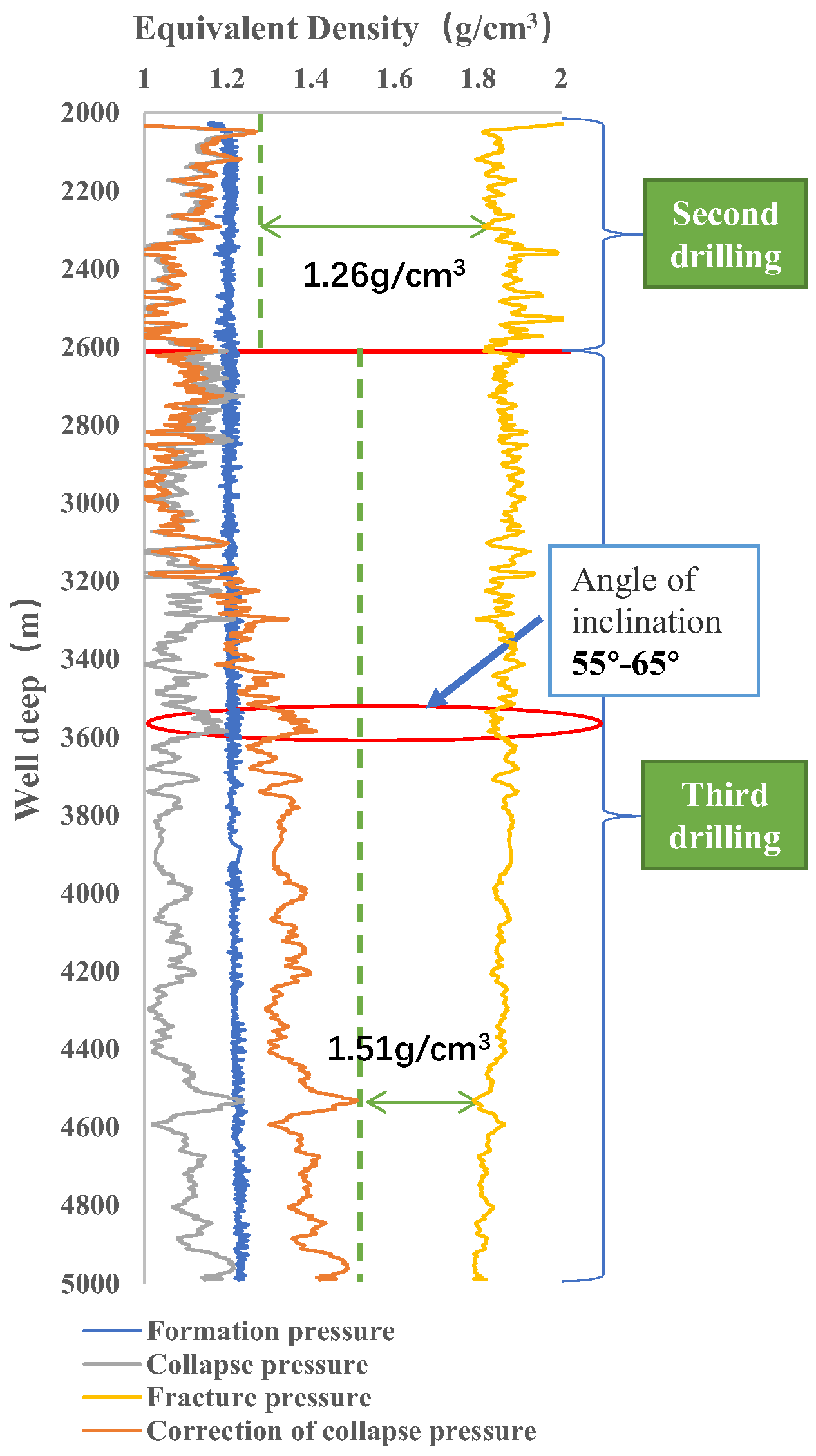Study of the Wellbore Instability Mechanism of Shale in the Jidong Oilfield under the Action of Fluid
Abstract
:1. Introduction
2. Experiment on Mineral Composition and Mechanical Parameters of Bedded Shale
2.1. Mineral Composition and Fracture Development Characteristics
2.2. Triaxial Compressive Strength Test of Shale
- (1)
- When the loading direction is 0°~30° to the bedding, splitting failure mainly occurs along the bedding plane.
- (2)
- Shear slip mainly occurs along the bedding plane when the loading direction is between 30° and 75°, and the strength is the lowest between 50° and 60°.
- (3)
- When the loading direction is in the range of 75°~90° with bedding, shear failure of the shale body mainly occurs, and the strength is the largest.
2.3. Triaxial Compressive Strength Test of Shale under Different Fluid Immersions
2.4. Tensile Strength Test of Shale
3. Study on the Deterioration Law of Shale under the Action of Fluid
4. Field Case Analysis
5. Conclusions
- (1)
- The shale in the Nanpu Depression is mainly argillaceous with dense and hard structures. Scanning electron microscopy showed that the pores were not developed, and the micropores were sporadically distributed, but the microcracks and micropores were relatively developed.
- (2)
- Considering the collapse and rupture of the wellbore, the collapse belongs to bulk shear when the well inclination is 0°~30°, and the rupture pressure and collapse pressure are both low. When the well inclination is 30°~60°, the drilling fluid density window is the narrowest. Precise pressure control should be ensured. When the inclination angle is 60°~90°, the collapse belongs to bedding splitting, and both the collapse pressure and the rupture pressure increase.
- (3)
- Through the oil–water immersion strength deterioration experiment, the effect of shale oil-based drilling fluid in the Nanpu block is better than that of water-based drilling fluid.
- (4)
- An analysis revealed that after the drilling fluid contacts the shale formation, the formation near the borehole wall quickly absorbs water, and its water content quickly reaches the saturation value, which substantially changes the mechanical parameters of the rock, which is manifested as a sharp decrease in rock strength. The formation near the borehole wall becomes a softening zone, which hinders borehole wall instability.
Author Contributions
Funding
Data Availability Statement
Conflicts of Interest
References
- Zhao, W.; Liu, Y.; Wang, T.; Ranjith, P.G.; Zhang, Y. Stability Analysis of Wellbore for Multiple Weakness Planes in Shale Formations. Geomech. Geophys. Geo-Energy Geo-Resour. 2021, 7, 44. [Google Scholar] [CrossRef]
- Liu, X.; Zeng, W.; Liang, L.; Lei, M. Wellbore Stability Analysis for Horizontal Wells in Shale Formations. J. Nat. Gas Sci. Eng. 2016, 31, 1–8. [Google Scholar] [CrossRef]
- Li, Y.; Fu, Y.; Tang, G.; She, C.; Guo, J.; Zhang, J. Effect of Weak Bedding Planes on Wellbore Stability for Shale Gas Wells. In Proceedings of the IADC/SPE Asia Pacific Drilling Technology Conference and Exhibition, Tianjin, China, 9–11 July 2012. [Google Scholar]
- Heng, S.; Guo, Y.; Yang, C.; Daemen, J.J.K.; Li, Z. Experimental and Theoretical Study of the Anisotropic Properties of Shale. Int. J. Rock Mech. Min. Sci. 2015, 74, 58–68. [Google Scholar] [CrossRef]
- Al-Bazali, T. The Impact of Water Content and Ionic Diffusion on the Uniaxial Compressive Strength of Shale. Egypt. J. Pet. 2013, 22, 249–260. [Google Scholar] [CrossRef] [Green Version]
- Zhang, Q.; Fan, X.; Chen, P.; Ma, T.; Zeng, F. Geomechanical Behaviors of Shale after Water Absorption Considering the Combined Effect of Anisotropy and Hydration. Eng. Geol. 2020, 269, 105547. [Google Scholar] [CrossRef]
- Wang, Y.; Liu, X.; Liang, L.; Xiong, J. Experimental Study on the Damage of Organic-Rich Shale during Water-Shale Interaction. J. Nat. Gas Sci. Eng. 2020, 74, 103103. [Google Scholar] [CrossRef]
- Abdideh, M.; Mafakher, A. Wellbore Stability Analysis in Oil and Gas Drilling by Mechanical, Chemical and Thermal Coupling (Case Study in the South of Iran). Geotech. Geol. Eng. 2021, 39, 3115–3131. [Google Scholar] [CrossRef]
- Zou, D.; Han, Z.; Huang, H. Sensitivity Analysis of Time Dependent Wellbore Instability and Application. In Proceedings of the International Field Exploration and Development Conference 2019, Chengdu, China, 16–18 September 2019; Springer: Singapore, 2020; pp. 534–550. [Google Scholar]
- Changhao, W.; Ling, Z.; Shibin, L.; Huizhi, Z.; Kai, L.; Xiaoming, W.; Chunhua, W. Time-Sensitive Characteristics of Bedding Shale Deterioration under the Action of Drilling Fluid. Lithosphere 2022, 2022, 3019090. [Google Scholar] [CrossRef]
- Ding, L.; Lv, J.; Wang, Z.; Liu, B. Borehole Stability Analysis: Considering the Upper Limit of Shear Failure Criteria to Determine the Safe Borehole Pressure Window. J. Pet. Sci. Eng. 2022, 212, 110219. [Google Scholar] [CrossRef]
- Peng, S.; Shevchenko, P.; Periwal, P.; Reed, R.M. Water-Oil Displacement in Shale: New Insights from a Comparative Study Integrating Imbibition Tests and Multiscale Imaging. SPE J. 2021, 26, 3285–3299. [Google Scholar] [CrossRef]
- Zhang, S.W.; Shou, K.J.; Xian, X.F.; Zhou, J.P.; Liu, G.J. Fractal Characteristics and Acoustic Emission of Anisotropic Shale in Brazilian Tests. Tunn. Undergr. Space Technol. 2018, 71, 298–308. [Google Scholar] [CrossRef]
- Saleh, T.A. Advanced Trends of Shale Inhibitors for Enhanced Properties of Water-Based Drilling Fluid. Upstream Oil Gas Technol. 2022, 8, 100069. [Google Scholar] [CrossRef]
- Jiang, Z.; Yu, S.; Deng, H.; Deng, J.; Zhou, K. Investigation on Microstructure and Damage of Sandstone Under Cyclic Dynamic Impact. IEEE Access 2019, 7, 145–158. [Google Scholar] [CrossRef]
- He, S.; Liang, L.; Zeng, Y.; Ding, Y.; Lin, Y.; Liu, X. The Influence of Water-Based Drilling Fluid on Mechanical Property of Shale and the Wellbore Stability. Petroleum 2016, 2, 61–66. [Google Scholar] [CrossRef] [Green Version]
- Zhang, Q.; Yao, B.; Fan, X.; Li, Y.; Li, M.; Zeng, F.; Zhao, P. A Modified Hoek-Brown Failure Criterion for Unsaturated Intact Shale Considering the Effects of Anisotropy and Hydration. Eng. Fract. Mech. 2021, 241, 107369. [Google Scholar] [CrossRef]
- Yew, C.H.; Chenevert, M.E.; Wang, C.L.; Osisanya, S.O. Wellbore Stress Distribution Produced by Moisture Adsorption. SPE Drill. Eng. 1990, 5, 311–316. [Google Scholar] [CrossRef]
- Moos, D.; Peska, P.; Finkbeiner, T.; Zoback, M. Comprehensive Wellbore Stability Analysis Utilizing Quantitative Risk Assessment. J. Pet. Sci. Eng. 2003, 38, 97–109. [Google Scholar] [CrossRef]
- Huang, T.; Cao, L.; Cai, J.; Xu, P. Experimental Investigation on Rock Structure and Chemical Properties of Hard Brittle Shale under Different Drilling Fluids. J. Pet. Sci. Eng. 2019, 181, 106185. [Google Scholar] [CrossRef]
- Dokhani, V.; Yu, M.; Bloys, B. A Wellbore Stability Model for Shale Formations: Accounting for Strength Anisotropy and Fluid Induced Instability. J. Nat. Gas Sci. Eng. 2016, 32, 174–184. [Google Scholar] [CrossRef]
- Ma, T.; Chen, P. Influence of Shale Bedding Plane on Wellbore Stability for Horizontal Wells. J. Southwest Pet. Univ. (Sci. Technol. Ed.) 2014, 36, 97–104. [Google Scholar] [CrossRef]
- Yan, C.; Deng, J.; Yu, B. Wellbore Stability in Oil and Gas Drilling with Chemical-Mechanical Coupling. Sci. World J. 2013, 2013, e720271. [Google Scholar] [CrossRef] [PubMed] [Green Version]
- Zhang, F.; Xie, S.Y.; Hu, D.W.; Shao, J.F.; Gatmiri, B. Effect of Water Content and Structural Anisotropy on Mechanical Property of Claystone. Appl. Clay Sci. 2012, 69, 79–86. [Google Scholar] [CrossRef]
- Liu, J.; Yang, Z.; Sun, J.; Dai, Z.; You, Q. Experimental Investigation on Hydration Mechanism of Sichuan Shale (China). J. Pet. Sci. Eng. 2021, 201, 108421. [Google Scholar] [CrossRef]










| Loading Direction | Lithology | Confining Pressure (MPa) | Compressive Strength (MPa) | Young’s Modulus (MPa) | Poisson’s Ratio |
|---|---|---|---|---|---|
| Vertical bedding direction | Light gray fine shale | 60 | 99.817 | 14,924.7 | 0.16 |
| Parallel bedding direction | Dark gray mud shale | 60 | 67.146 | 9979.2 | 0.20 |
| Load Direction | Cohesion (MPa) | Angle of Internal Friction (°) | Coefficient of Internal Friction |
|---|---|---|---|
| Parallel bedding direction | 11.386 | 12.95 | 0.23 |
| Vertical bedding di-rection | 22.464 | 13.06 | 0.232 |
| 30° bedding direction | 15.698 | 7.57 | 0.133 |
| 45° bedding direction | 8.338 | 6.39 | 0.112 |
| 60° bedding direction | 4.775 | 4.4 | 0.077 |
| Types of Experiments | Confining Pressure (MPa) | Compressive Strength (MPa) | Young’s Modulus (MPa) | Poisson’s Ratio |
|---|---|---|---|---|
| Soaking in water (parallel) | broken | 0 | 0 | 0 |
| 0 | 0 | 0 | ||
| 0 | 0 | 0 | ||
| Soaking in oil (parallel) | 60 | 49.677 | 9537.9 | 0.21 |
| broken | 0 | 0 | 0 | |
| 60 | 41.778 | 13,057.2 | 0.2 | |
| Soaking in water (vertical) | 60 | 38.944 | 15,396.5 | 0.21 |
| 60 | 38.869 | 8608.5 | 0.23 | |
| Soaking in oil (vertical) | 60 | 64.225 | 13,322.7 | 0.19 |
| 60 | 63.523 | 10,173.9 | 0.22 |
| Coring Direction | Stratum | Tensile Strength (MPa) | Average Tensile Strength (MPa) |
|---|---|---|---|
| Vertical | Es1 | 7.99 | 8.07 |
| 8.15 | |||
| Parallel | Es1 | 3.39 | 3.22 |
| 3.05 |
Disclaimer/Publisher’s Note: The statements, opinions and data contained in all publications are solely those of the individual author(s) and contributor(s) and not of MDPI and/or the editor(s). MDPI and/or the editor(s) disclaim responsibility for any injury to people or property resulting from any ideas, methods, instructions or products referred to in the content. |
© 2022 by the authors. Licensee MDPI, Basel, Switzerland. This article is an open access article distributed under the terms and conditions of the Creative Commons Attribution (CC BY) license (https://creativecommons.org/licenses/by/4.0/).
Share and Cite
Xu, X.; Chen, C.; Zhou, Y.; Pan, J.; Song, W.; Zhu, K.; Wang, C.; Li, S. Study of the Wellbore Instability Mechanism of Shale in the Jidong Oilfield under the Action of Fluid. Energies 2023, 16, 2989. https://doi.org/10.3390/en16072989
Xu X, Chen C, Zhou Y, Pan J, Song W, Zhu K, Wang C, Li S. Study of the Wellbore Instability Mechanism of Shale in the Jidong Oilfield under the Action of Fluid. Energies. 2023; 16(7):2989. https://doi.org/10.3390/en16072989
Chicago/Turabian StyleXu, Xiaofeng, Chunlai Chen, Yan Zhou, Junying Pan, Wei Song, Kuanliang Zhu, Changhao Wang, and Shibin Li. 2023. "Study of the Wellbore Instability Mechanism of Shale in the Jidong Oilfield under the Action of Fluid" Energies 16, no. 7: 2989. https://doi.org/10.3390/en16072989




